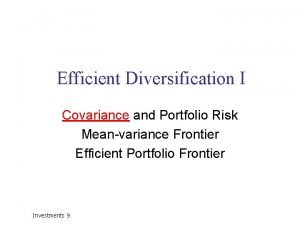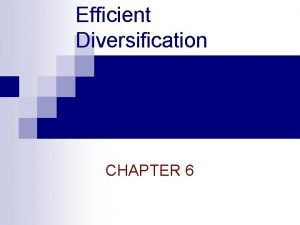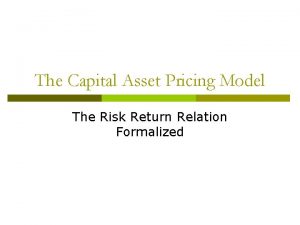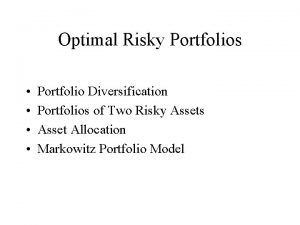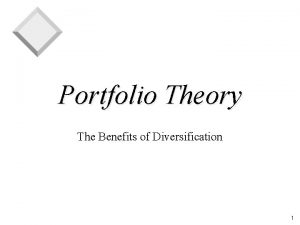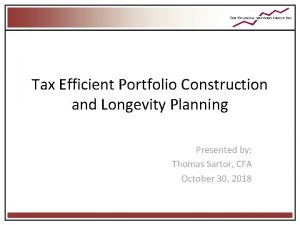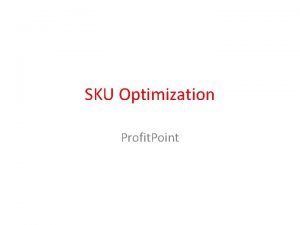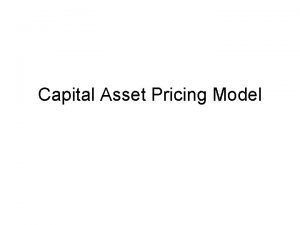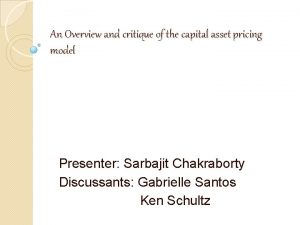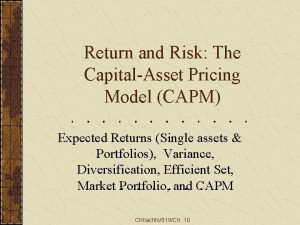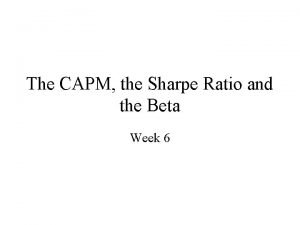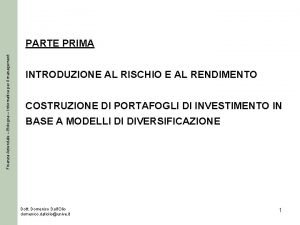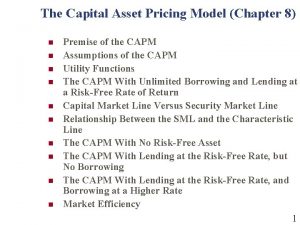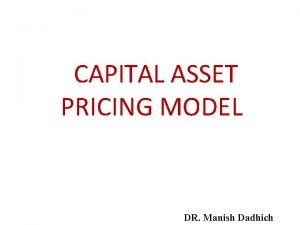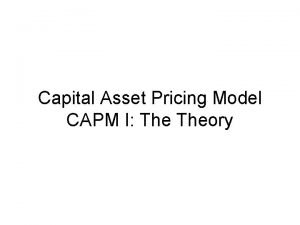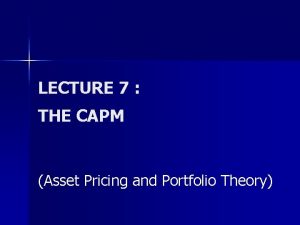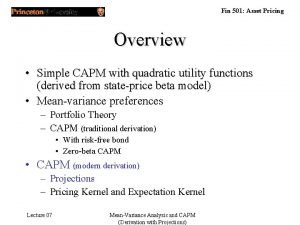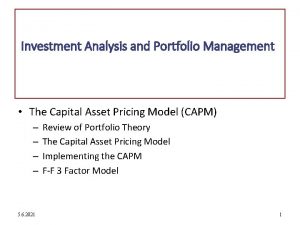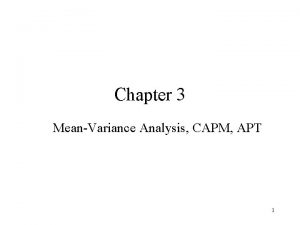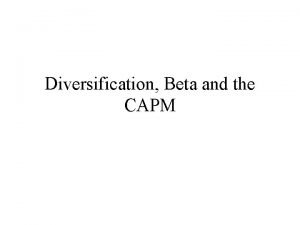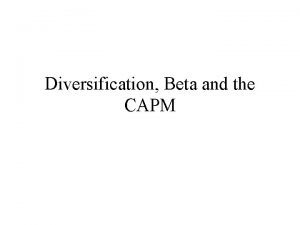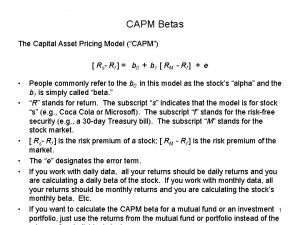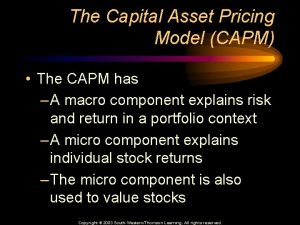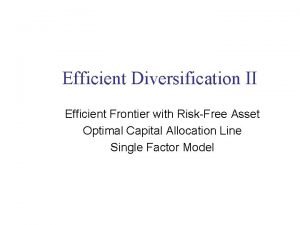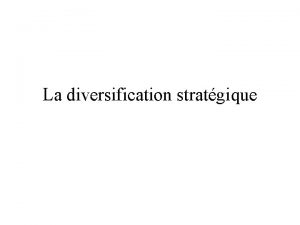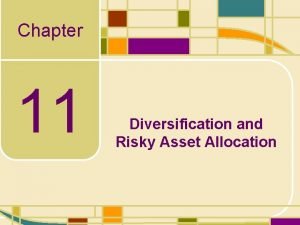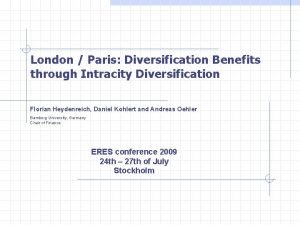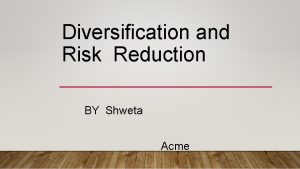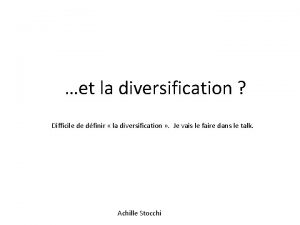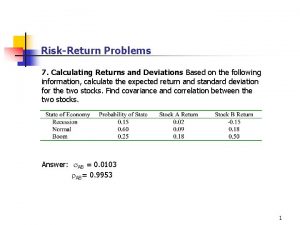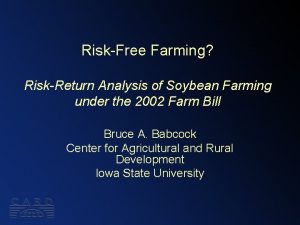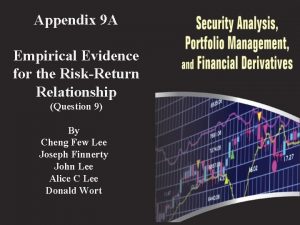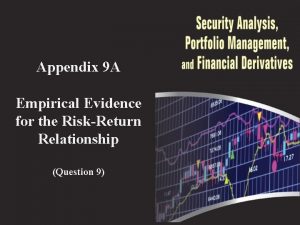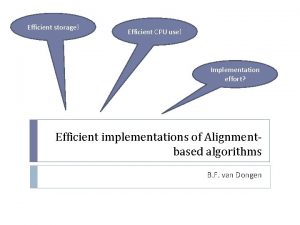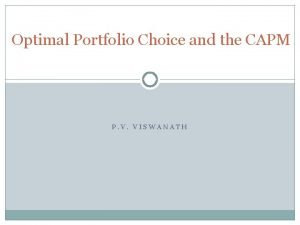Efficient Portfolio Diversification CAPM RiskReturn Optimization Portfolio Goal























![CAPM Equation F [E(Rm) – Rf] = Market Risk Premium (MRP) F Rf = CAPM Equation F [E(Rm) – Rf] = Market Risk Premium (MRP) F Rf =](https://slidetodoc.com/presentation_image_h/8bfcbba8bf84155070e3e38b87b1dbc8/image-24.jpg)



- Slides: 27

Efficient Portfolio Diversification CAPM Risk-Return Optimization

Portfolio Goal F Combine assets such that: F Minimize risk for a given return OR F Maximise return for a given risk Ø‘biggest bang for the buck’

Process Estimate Inputs Computer Optimization Output: Asset weights 1. Expected return for every asset Minimize p 2 2. Covariance between every pair of assets E(rp) = target and weights add to 1 Output is: w 1 w 2 w 3. . . w. N such that

Inputs F Expected Return: ØE(Ri) for every asset i F Covariance: ØCov(Ri, Rj) for every pair of assets i and j F How to estimate them? ØScenario Analysis ØHistorical Data

Scenario Analysis F Choose investment horizon F Consider every scenario possible over horizon F Guess the chance (probability) of a given scenario occurring F Guess the return in a given scenario F Compute E(Ri), i 2 and Cov(Ri, Rj) ØNote: Cov(Ri, Ri) = i 2 u covariance with itself is variance

Historical Data F Typical F Two to use daily or monthly data offsetting considerations: ØLong history gives more precise estimates however, ØLong history uses outdated data u Trade-off: use judgement

Portfolio E(rp) and p 2 Asset Case F Notes: is the correlation coefficient

Changing weights: 2 Risky Assets F You move along the curve

Effect of Correlation F Lower correlation: more northwest movement

3 -Asset Case F Notice the pattern going from 2 -assets case to 3 -assets case

Many Asset Case: Optimization F Throw in expected returns, variances, covariances into a computer and: Minimize: p such that E(Rp) = target value (constant) and w 1 + w 2 +. . . + w. N = 1 F Computer spits out w 1 , w 2 , . . . , w. N F Excel can do it

Graphical Analysis E(rp) and p for every possible target value of expected return F Plot

Minimum Variance Frontier F Sensible investors pick from portfolios on the Efficient Frontier because they have the biggest bang for the buck

Many Asset Case F When N is large, say, 1000 assets You need F 1000 Expected returns F 1000 Variances F 499, 000 Covariances!!!!! ØThere about 7, 000 stocks in the US alone

Allocating Between Risk-free Asset and Risky Portfolio F If cash or risk-free asset is available: F There will be one unique risky portfolio that is best among all available on the Efficient Frontier F That risky portfolio = Tangency portfolio

· F Choose C based on your risk taking ability

It turns out that. . . . F If EVERYONE used this technique, you get CAPM F And… F Everyone’s risky asset investment is the Market Portfolio

CAPM Assumptions F Investors are mean-variance optimizers F Investors have homogeneous expectations ØThey have the same information ØThey see the same mean-variance frontier F Frictionless capital markets

CAPM: Implications F Investors hold the market portfolio F The market portfolio is on the efficient frontier F Beta is appropriate measure of risk for individual securities F Variance (Std. Dev. ) is the appropriate measure of risk for entire portfolios

In Equilibrium. . . Which gives us

Beta F Measures the sensitivity of security return to the changes in market return F Measures the contribution the security makes to the total risk (std. dev. ) of the overall portfolio

CAPM F The main contribution of CAPM is to derive an exact relation between risk and return F The main message of CAPM is that ØInvestors hold fully diversified (market) portfolio ØDiversified portfolios have no unsystematic risk ØTherefore, for individual securities, risk is measured by the contribution that security makes to the risk of the (market) portfolio, i. e. , systematic risk or beta

Portfolio Diversification Average annual standard deviation (%) 49. 2 Diversifiable risk 23. 9 19. 2 Non-diversifiable Risk 1 10 20 30 40 1000 Number of stocks in portfolio
![CAPM Equation F ERm Rf Market Risk Premium MRP F Rf CAPM Equation F [E(Rm) – Rf] = Market Risk Premium (MRP) F Rf =](https://slidetodoc.com/presentation_image_h/8bfcbba8bf84155070e3e38b87b1dbc8/image-24.jpg)
CAPM Equation F [E(Rm) – Rf] = Market Risk Premium (MRP) F Rf = Risk Free rate F βi = stock beta

Asset expected return E (Ri) The Security Market Line (SML) = E (RM ) – Rf E (RM) Rf Asset beta 0 M = 1. 0

Estimating Beta F Beta is the slope of a linear regression F Vertical (Y) axis: Return o stock for which you want to estimate beta: Ri F Horizontal (X) axis: Contemporaneous return on the market portfolio: Rm

Estimating Beta F Slope of regression line of Ri on Rm Ri Rm
 Variance of 3 asset portfolio formula
Variance of 3 asset portfolio formula Portfolio diversification
Portfolio diversification Productively efficient vs allocatively efficient
Productively efficient vs allocatively efficient Productive inefficiency and allocative inefficiency
Productive inefficiency and allocative inefficiency Allocative efficiency
Allocative efficiency Productively efficient vs allocatively efficient
Productively efficient vs allocatively efficient Allocative efficiency vs productive efficiency
Allocative efficiency vs productive efficiency Portfolio diversification eliminates:
Portfolio diversification eliminates: Optimal risky portfolio weight formula
Optimal risky portfolio weight formula Portfolio diversification theory
Portfolio diversification theory Efficient portfolio construction
Efficient portfolio construction Sku rationalization
Sku rationalization Introduction to capm
Introduction to capm Capm critique
Capm critique Capm assumptions
Capm assumptions Capm
Capm Sharpe ratio vs capm
Sharpe ratio vs capm Expected return beta relationship
Expected return beta relationship Volatilità informatica
Volatilità informatica Cml vs sml
Cml vs sml Limitations of capm
Limitations of capm Arbitrage pricing theory formula
Arbitrage pricing theory formula Discount rate capm
Discount rate capm Expected return of a portfolio
Expected return of a portfolio Simple capm
Simple capm The capm predicts the relationship between _______.
The capm predicts the relationship between _______. Formula capm excel
Formula capm excel Capm e apt
Capm e apt
